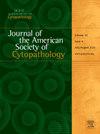ROSE on small-cell lung carcinoma involvement of mediastinal lymph nodes: Performance evaluation at our institution
Q2 Medicine
Journal of the American Society of Cytopathology
Pub Date : 2025-01-27
DOI:10.1016/j.jasc.2025.01.005
引用次数: 0
Abstract
Introduction
Recognition of lymph node involvement by small-cell lung carcinoma (SCLC) is challenging, especially during rapid onsite evaluation (ROSE). This distinction might carry clinical significance especially for staging and potential therapy.
Materials and methods
Cases with ROSE of lymph nodes for assessment of involvement by SCLC between 2020 and 2024 at our institution were reviewed. Adequacy evaluation results were correlated with the final diagnosis. Smears used during ROSE from cases with diagnostic discrepancies between ROSE and final diagnosis were retrieved for additional review. Interpretation accuracy was measured, and useful features for recognizing SCLC and possible contributing factors for misrecognition were studied.
Results
The majority of the cases show concordance between ROSE interpretation and the final review. Most discrepancies are due to under-recognition of scant SCLC cells from background lymphocytes or abundant necrosis. Rapid Papanicolaou-stained smears showed better sensitivity and specificity for recognizing SCLC cells than Diff-Quick stain during ROSE. Pathologists in practice for a longer period (>5 years) are more likely to accurately distinguish the carcinoma cells. Shorter time seems to have been spent onsite for evaluation of cases with under-recognized SCLC cells, but the association is not statistically significant.
Conclusions
Accurately recognizing lymph node involvement by SCLC during ROSE is important for timely diagnosis, triage, and management of cases. Several cytologic features should be utilized for accurately distinguishing SCLC cells from lymphocytes. Experience gained with practice increases diagnostic accuracy during ROSE, and rushing should be avoided. Knowledge of clinical impression and clear communication with clinicians should always be encouraged.
小细胞肺癌累及纵隔淋巴结:本机构的表现评估。
小细胞肺癌(SCLC)淋巴结累及的识别具有挑战性,特别是在快速现场评估(ROSE)中。这种区别可能具有临床意义,特别是对分期和潜在的治疗。材料和方法:回顾我院2020 - 2024年SCLC累及淋巴结ROSE病例。充分性评价结果与最终诊断结果相关。在ROSE和最终诊断之间存在诊断差异的病例中使用的涂片被检索以进行进一步的审查。测量了判读精度,并研究了识别SCLC的有用特征和可能导致错误识别的因素。结果:大多数病例的ROSE解释与最终复查结果一致。大多数差异是由于背景淋巴细胞或大量坏死对少量SCLC细胞的识别不足。快速巴氏染色对SCLC细胞识别的敏感性和特异性优于Diff-Quick染色。病理医师执业时间较长(50 ~ 5年),更容易准确区分癌细胞。在现场评估未被识别的SCLC细胞的病例似乎花费了更短的时间,但这种关联在统计学上并不显著。结论:准确识别ROSE期间SCLC的淋巴结累及对病例的及时诊断、分诊和处理具有重要意义。几个细胞学特征应用于准确区分SCLC细胞和淋巴细胞。实践中获得的经验增加了ROSE诊断的准确性,应避免匆忙。临床印象的知识和与临床医生的清晰沟通应始终得到鼓励。
本文章由计算机程序翻译,如有差异,请以英文原文为准。
求助全文
约1分钟内获得全文
求助全文
来源期刊

Journal of the American Society of Cytopathology
Medicine-Pathology and Forensic Medicine
CiteScore
4.30
自引率
0.00%
发文量
226
审稿时长
40 days
 求助内容:
求助内容: 应助结果提醒方式:
应助结果提醒方式:


